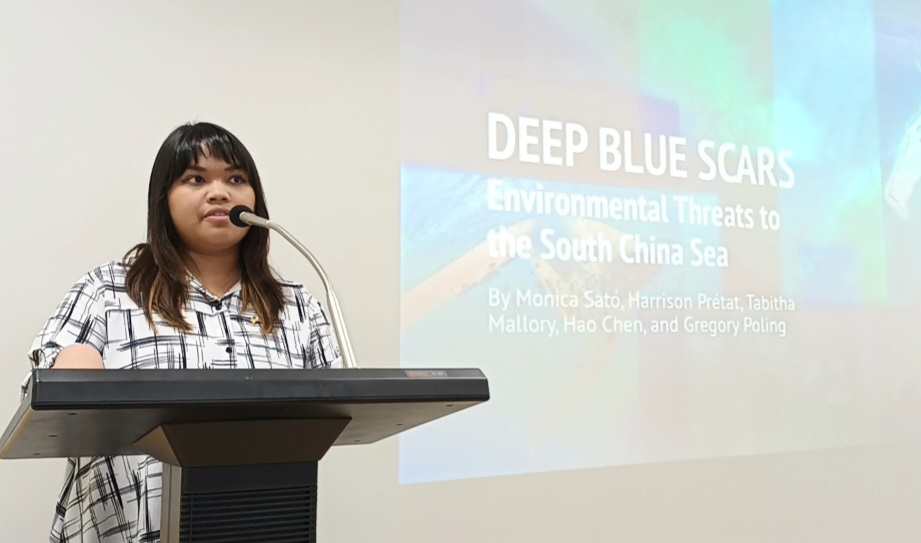

MANILA – Severe coral reef damage was seen in various parts of South China Sea believed to be caused by dredging and giant clam harvesting done by Chinese fishers.
This is revealed by a study undertaken by the Center for Strategic and International Studies (CSIS) after over a year researching on environmental damage in the South China Sea using commercial satellite imagery on 181 occupied and unoccupied features in the area.
In a briefing in Mandaluyong City on Thursday, CSIS Asia Maritime Transparency Initiative Director Gregory B. Poling said that the research, entitled “Deep Blue Scars: Environmental Threats to the South China Sea” estimated that a total of 21,000 acres of reef were damaged due to dredging and big clam harvesting by Chinese fishers, compared to the 1,500 acres by Vietnam, though he believes that the real numbers might be higher.
“The bare minimum reef damage in South China Sea is 21,000 acres by China and just 1,500 by Vietnam. So, China has destroyed at least 15 times as much reef as Vietnam. But we know that is an under count on the part of China. We know it’s an undercount of China's damage because it only captures the scarring on the shallowest parts of the reefs, the reef crests around the edges that are so shallow that you can see the bottom through satellite images,” Poling added.
During the same briefing, CSIS Asia Maritime Transparency Initiative Research Associate Monica Sato explained why states dredge and that is “really to build their outposts and maritime entitlements in the South China Sea and to support their sovereignty claims as well.”
According to Sato, China mainly uses the method called "cutter suction dredging" where dredgers slice through the reef, pump the sediment that is collected through floating pipelines and then the sediment is then deposited on areas targeted for landfill.

CSIS Asia Maritime Transparency Initiative Research Associate Monica Sato presents the latest study on severe reef damage in the South China Sea caused by dredging, landfill and giant clam harvesting by Chinese and Vietnamese fishers. (Photo courtesy of Karen A. Ow-Yong).
However, Sato emphasized that dredging is considered the most detrimental to the environment as this removes essential reef substructures and also incapacitates the reef’s ability to repair itself over time.
“So, when we totalled the number of reefs destroyed by both dredging and landfill, we found that China has actually destroyed 4,500 acres of reefs through dredging and landfill. Vietnam comes in second with 1,500 reefs destroyed, and Malaysia, the Philippines and Taiwan barely scratched the surface. They contribute to less than 100 acres of destroyed reef,” Sato added.
Sato also mentioned the effect of giant clam harvesting in the South China Sea as this became popular in China between 2012 to 2015 because of its resemblance to elephant ivory.
“As we all know, elephant ivory is illegal to extract and is also protected by international law. So, because it’s so similar to ivory it became very popular in Chinese statuary, jewelry, and was sold for very high prices. The most expensive processed giant clam was sold for about USD106,000,” Sato said.
She also revealed that the method used by Chinese fishermen, mainly from the port of Tanmen, to extract giant clams is to use specially made brass propellers and “the boat moves around in a semi-circle on an anchor chain which is why you see these half-moon shapes created by the anchors.”
Sato stressed that this process will actually take decades, if not centuries, to recover and the process is also very indiscriminate, which means it will dig up both live and dead clams or fossilized clams into the reef, making it very detrimental to the ecosystem.
The study shows that China has actually destroyed an extra 16,000 acres of reef, bringing up the total area of reefs destroyed by dredging and landfill and giant clam harvesting to up to 21,000 acres of reef.
Meanwhile, Poling asserts that the “only way to stop this is to convince Beijing to stop this”.
“We need to see an international coalition starting with Southeast Asia led by the claimants to better survey this damage, account for it, and hopefully negotiate some joint marine scientific research and fisheries management regimes among the Southeast Asian claimants,” he said.




